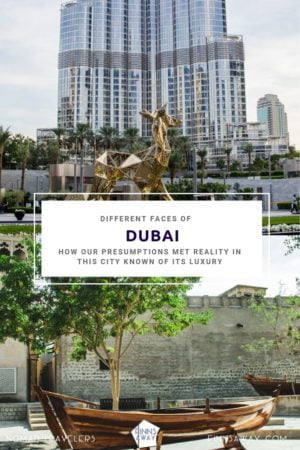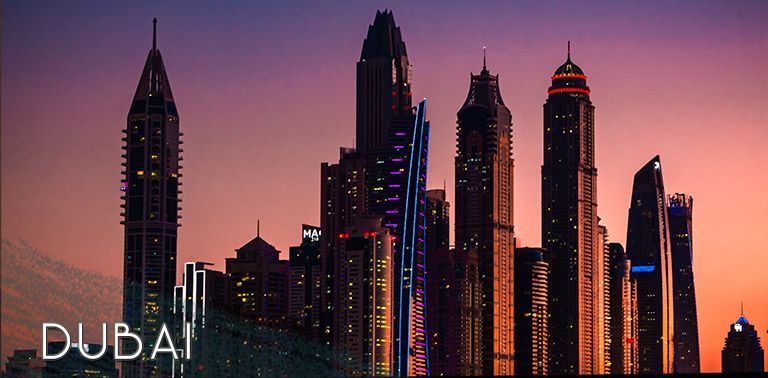
Dazzled by Dubai
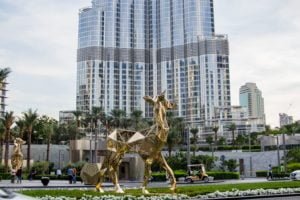 Dubai is a hugely popular holiday destination in the United Arab Emirates. First thoughts about it are often related to skyscrapers, shopping malls, man-made islands and beautiful beaches. We also thought that Dubai is ridiculously expensive and that it’s hard to get around by foot. Well, there definitely are a lot of skyscrapers, luxury and beaches, but it turned out that the presumptions that we had from travel articles and general discussion were only a small part of truth, and there is something for everyone in Dubai. In this article we share our views and feelings of Dubai, with some travel tips.
Dubai is a hugely popular holiday destination in the United Arab Emirates. First thoughts about it are often related to skyscrapers, shopping malls, man-made islands and beautiful beaches. We also thought that Dubai is ridiculously expensive and that it’s hard to get around by foot. Well, there definitely are a lot of skyscrapers, luxury and beaches, but it turned out that the presumptions that we had from travel articles and general discussion were only a small part of truth, and there is something for everyone in Dubai. In this article we share our views and feelings of Dubai, with some travel tips.
Contents of this post:
General facts about Dubai
Must-see sights (that everyone visits)
– Burj Khalifa, Dubai Fountain and Dubai Mall
– Burj Al Arab and Palm Jumeirah
– Other favorite sites
Bur Dubai and Deira, our favorite parts of Dubai
Dubai on a budget
It’s commonly known that there are a lot of foreign workers in Dubai and in UAE in general. However, we were surprised to find out, that in fact as much as approximately 85 % of the residents are expatriates. Basically all the workers you see while your stay are from abroad, and the emirates themselves mostly have governmental jobs. Majority of the expats are from Asia, especially from India, Pakistan, Bangladesh and Philippines. Mixture of cultures is interesting to say the least.
The huge size of Dubai downtown area was another surprise, and while it’s not true that you couldn’t explore the city on foot, the distances between different parts of the city are very long. It’s still recommendable to explore different neighborhoods, not just the most famous downtown areas. Metro is a convenient way to move around and between the different parts of the city, though also distances from metro stations to places of interest, let’s say to beaches for example, can be several kilometers, so pack comfortable walking shoes!
Related post: Public transport in UAE
Must-see sights (that everyone visits)
There are so many travel guides written about the most significant sights of Dubai, that we are not going to focus too much on them in this article. But somehow a visit to Dubai would feel incomplete if you wouldn’t go and see at least these following iconic sites yourself, so here are short introductions of the most popular sights in Dubai.
Burj Khalifa, Dubai Fountain and Dubai Mall
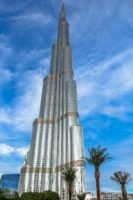 First and foremost, the combo of Burj Khalifa skyscraper, Dubai Fountain and Dubai Mall. Burj Khalifa is the world’s tallest building (829,8 meters), and a real architectural beauty. Many tourists buy a ticket to get inside the tower, but seeing it from outside is also fascinating. Don’t miss out the laser and light shows on the huge LED wall of Burj Khalifa, combined with the fascinating, impressive dance and light show of the huge Dubai Fountain in man-made Burj Khalifa Lake. Right next door is also Dubai Mall, the second-largest mall in the world. Even if you are not planning to buy anything, a visit to astonishing Dubai Mall is a must. I guess you could spend hours just walking around, and the attractions include Dubai Aquarium and Underwater Zoo, a genuine fossil of Diplodocus dinosaur called Dubai Dino, a Virtual Reality Theme Park, a huge cinema and hallways decorated with different themes.
First and foremost, the combo of Burj Khalifa skyscraper, Dubai Fountain and Dubai Mall. Burj Khalifa is the world’s tallest building (829,8 meters), and a real architectural beauty. Many tourists buy a ticket to get inside the tower, but seeing it from outside is also fascinating. Don’t miss out the laser and light shows on the huge LED wall of Burj Khalifa, combined with the fascinating, impressive dance and light show of the huge Dubai Fountain in man-made Burj Khalifa Lake. Right next door is also Dubai Mall, the second-largest mall in the world. Even if you are not planning to buy anything, a visit to astonishing Dubai Mall is a must. I guess you could spend hours just walking around, and the attractions include Dubai Aquarium and Underwater Zoo, a genuine fossil of Diplodocus dinosaur called Dubai Dino, a Virtual Reality Theme Park, a huge cinema and hallways decorated with different themes.
Burj Al Arab and Palm Jumeirah
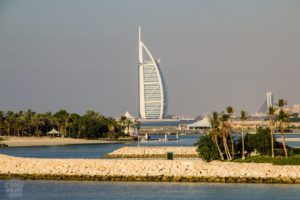 Another favorite among visitors and photographers is Burj Al Arab, the iconic, sail-shaped luxury hotel building that stands on an artificial island. Travel picture from a beach with Burj Al Arab is a true classic. Talking about artificial islands, the palm-shaped Palm Jumeirah archipelago has become one of the symbols of Dubai. There are numerous luxury hotels in the islands, best known is the photogenic Atlantis in the far end of the archipelago, but also huge amount of apartment buildings, and of course malls.
Another favorite among visitors and photographers is Burj Al Arab, the iconic, sail-shaped luxury hotel building that stands on an artificial island. Travel picture from a beach with Burj Al Arab is a true classic. Talking about artificial islands, the palm-shaped Palm Jumeirah archipelago has become one of the symbols of Dubai. There are numerous luxury hotels in the islands, best known is the photogenic Atlantis in the far end of the archipelago, but also huge amount of apartment buildings, and of course malls.
Palm Jumeirah can be reached easily using a quite expensive monorail, but it’s also fully possible to walk there, though notice that the distance from mainland to Atlantis Hotel is several kilometers. We made a walking tour in Palm Jumeirah from Dubai Internet City, and have to say that the feel on this artificial island, as well as in part of the Internet City, was quite unreal. Walking in the streets and parks was like being in a setting of a movie, everything was somehow so unrealistic and plastic, like some kind of bubble of perfection. It’s hard to explain really. Palm Jumeirah is one of three artificial archipelagos in Dubai, a complex called the Palm Islands, and there are several other islands also under construction.
Other favorite sites
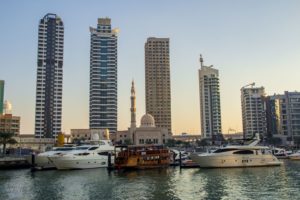 The list of popular sights in Dubai is nearly endless, but to our list of must-see destinations we would still add luxurious Dubai Marina area. Roaming along the Jumeirah Beach Walk in Dubai Marina, admiring the skyscrapers, yachts and luxury cars is a classic. Other additions to the list would be the sandy and scenic Jumeirah Beach, the Mall of the Emirates with its inside skiing center and “winter wonderland” Ski Dubai, Zabeel Park with the huge picture-frame-shaped Dubai Frame, the souks of Deira and Dubai Museum in Bur Dubai. Aquaventure Waterpark in Palm Jumeirah is a family holiday classic, and there for sure is a lot to see and do with kids also elsewhere in Dubai. What is also worth mentioning, is that many visitors nowadays head out from the downtown area to experience the desert with its sand dunes. There are all kinds of tours available from camel caravans to sand boarding.
The list of popular sights in Dubai is nearly endless, but to our list of must-see destinations we would still add luxurious Dubai Marina area. Roaming along the Jumeirah Beach Walk in Dubai Marina, admiring the skyscrapers, yachts and luxury cars is a classic. Other additions to the list would be the sandy and scenic Jumeirah Beach, the Mall of the Emirates with its inside skiing center and “winter wonderland” Ski Dubai, Zabeel Park with the huge picture-frame-shaped Dubai Frame, the souks of Deira and Dubai Museum in Bur Dubai. Aquaventure Waterpark in Palm Jumeirah is a family holiday classic, and there for sure is a lot to see and do with kids also elsewhere in Dubai. What is also worth mentioning, is that many visitors nowadays head out from the downtown area to experience the desert with its sand dunes. There are all kinds of tours available from camel caravans to sand boarding.
Bur Dubai and Deira, our favorite parts of Dubai
During only a few days stay, we obviously didn’t have time to explore all the parts of Dubai, but definitely wanted to see something else than skyscrapers and luxury. We found a very different Dubai from along the side streets of Deira, the area on the northern side of Dubai Creek, and also from Bur Dubai on the opposite side of the Creek. Deira and Bur Dubai actually are the oldest parts of Dubai, and used to be the commercial center of the emirate back in the days. Both Bur Dubai and Deira are quite huge areas, but most of the attractions are centered in Al Ras and Al Fahidi areas near the mouth of the Dubai Creek.
Market streets, local food and cargo boats in Deira
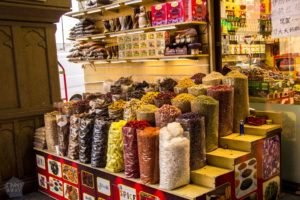 The main tourist attraction in Deira are the souks, meaning the market streets, were vendors sell pretty much everything. There are different souk streets and locations for example for gold, watches and jewelry, perfumes, spices and other food products, and of course for souvenirs. There are also a lot of hotels and high buildings in Deira, but when you dive deeper into the small streets, past the souks, suddenly all the luxury fades away and streets are full of local life. And by the locals I mean the expats from Asian and African countries. If time allows, forget maps and just wander on the streets and feel the soul of the area. Oh and have a lunch in one of the small food stalls or “local” restaurants, where you can find authentic Asian tastes with budget-friendly prices.
The main tourist attraction in Deira are the souks, meaning the market streets, were vendors sell pretty much everything. There are different souk streets and locations for example for gold, watches and jewelry, perfumes, spices and other food products, and of course for souvenirs. There are also a lot of hotels and high buildings in Deira, but when you dive deeper into the small streets, past the souks, suddenly all the luxury fades away and streets are full of local life. And by the locals I mean the expats from Asian and African countries. If time allows, forget maps and just wander on the streets and feel the soul of the area. Oh and have a lunch in one of the small food stalls or “local” restaurants, where you can find authentic Asian tastes with budget-friendly prices.
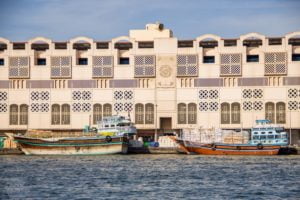 By the creek you will find a line of dinner cruise ships, but more interestingly an actual old port with run-down wooden cargo ships. Some of these colorful dhows make you wonder how on earth do they still even float, and the amount and variety of merchandise that are unloaded from and loaded in the ships, is overwhelming. This kind of boats have been used in the Arabian Peninsula for centuries, and not just for trading, but also for fishing and pearl diving. Against the background of modern skyscrapers, these cargo ships are a surprising sight, but somehow the combination summarizes the essence of Dubai.
By the creek you will find a line of dinner cruise ships, but more interestingly an actual old port with run-down wooden cargo ships. Some of these colorful dhows make you wonder how on earth do they still even float, and the amount and variety of merchandise that are unloaded from and loaded in the ships, is overwhelming. This kind of boats have been used in the Arabian Peninsula for centuries, and not just for trading, but also for fishing and pearl diving. Against the background of modern skyscrapers, these cargo ships are a surprising sight, but somehow the combination summarizes the essence of Dubai.
Arabic heritage quarters of Bur Dubai
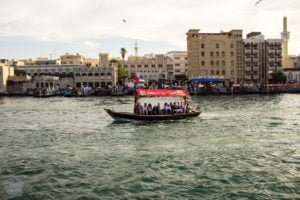 In Bur Dubai, on the other side of the creek, you will find more souks, and the so called old Dubai. The best way to get there from Deira is to hop in one of the old wooden boats, called abra, for a ride over the creek. This very local form of transportation is also popular among tourists, but the price for a single trip is only 1 AED, so roughly 0,25 €.
In Bur Dubai, on the other side of the creek, you will find more souks, and the so called old Dubai. The best way to get there from Deira is to hop in one of the old wooden boats, called abra, for a ride over the creek. This very local form of transportation is also popular among tourists, but the price for a single trip is only 1 AED, so roughly 0,25 €.
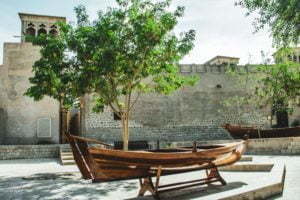 When in Al Fahidi area in Bur Dubai, many visitors head to Dubai Museum, which is located in Al-Fahidi Fort, that is built in 1787 to defend the Creek. Many reviews state that the museum worth a visit. When we were there, on the National Day of UAE, it was even free of charge, but it meant that it was also fully packed, and visitors needed to queue, so we skipped it. Instead we headed to explore the historical Dubai in Al Fahidi Historical District and in the Heritage Village quarters around Saruq Al-Hadid Archaeologial Museum and House of Sheik Saeed Al Maktoum close to the mouth of the creek. These traditionally built or renovated neighborhoods are a jump into old Arabic heritage and culture, and offer a great destination for self-guided walking tours.
When in Al Fahidi area in Bur Dubai, many visitors head to Dubai Museum, which is located in Al-Fahidi Fort, that is built in 1787 to defend the Creek. Many reviews state that the museum worth a visit. When we were there, on the National Day of UAE, it was even free of charge, but it meant that it was also fully packed, and visitors needed to queue, so we skipped it. Instead we headed to explore the historical Dubai in Al Fahidi Historical District and in the Heritage Village quarters around Saruq Al-Hadid Archaeologial Museum and House of Sheik Saeed Al Maktoum close to the mouth of the creek. These traditionally built or renovated neighborhoods are a jump into old Arabic heritage and culture, and offer a great destination for self-guided walking tours.
Dubai on a budget
In the beginning of this article I stated that one of our presumptions regarding Dubai and UAE in general was that it’s very expensive travel destination. While it’s true that it’s possible to spend huge sums of money there, and many travelers do, it’s also very well possible to explore it in budget. How to do it then? Well, first of all, search cheap rooms via Airbnb (if you are new in Airbnb, join and get a discount using this link). During our trip around UAE, when in Dubai we stayed a few nights in Deira, hosted by a lady from the Philippines, and a couple of nights more in a dorm room in Dubai Internet city, in a hostel type of apartment building.
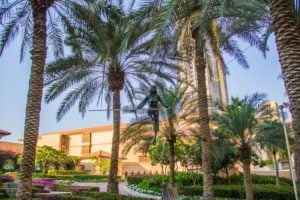 Other tips for saving money include using public transportation and walking around, and either choosing restaurants that are not aimed for tourist but for locals or preparing your meals yourself. Oh, and consider not buying any alcohol drinks, since those are super-expensive in UAE. Another thing is then related to sights and excursions; going up to Burj Khalifa, heading to a desert tour or relaxing in a luxury spa will raise your travel costs for sure, but if those would be on your must-do list instead of just walking around and seeing the city for free, save money for the trip in advance, and enjoy Dubai on your way. To balance things a bit, maybe you could spend a little less on accommodation and dining for example. To see how much we spent during our 11 days trip to UAE, check out this cost summary post.
Other tips for saving money include using public transportation and walking around, and either choosing restaurants that are not aimed for tourist but for locals or preparing your meals yourself. Oh, and consider not buying any alcohol drinks, since those are super-expensive in UAE. Another thing is then related to sights and excursions; going up to Burj Khalifa, heading to a desert tour or relaxing in a luxury spa will raise your travel costs for sure, but if those would be on your must-do list instead of just walking around and seeing the city for free, save money for the trip in advance, and enjoy Dubai on your way. To balance things a bit, maybe you could spend a little less on accommodation and dining for example. To see how much we spent during our 11 days trip to UAE, check out this cost summary post.
Related posts: Emirates of Sharjah and Ajman

